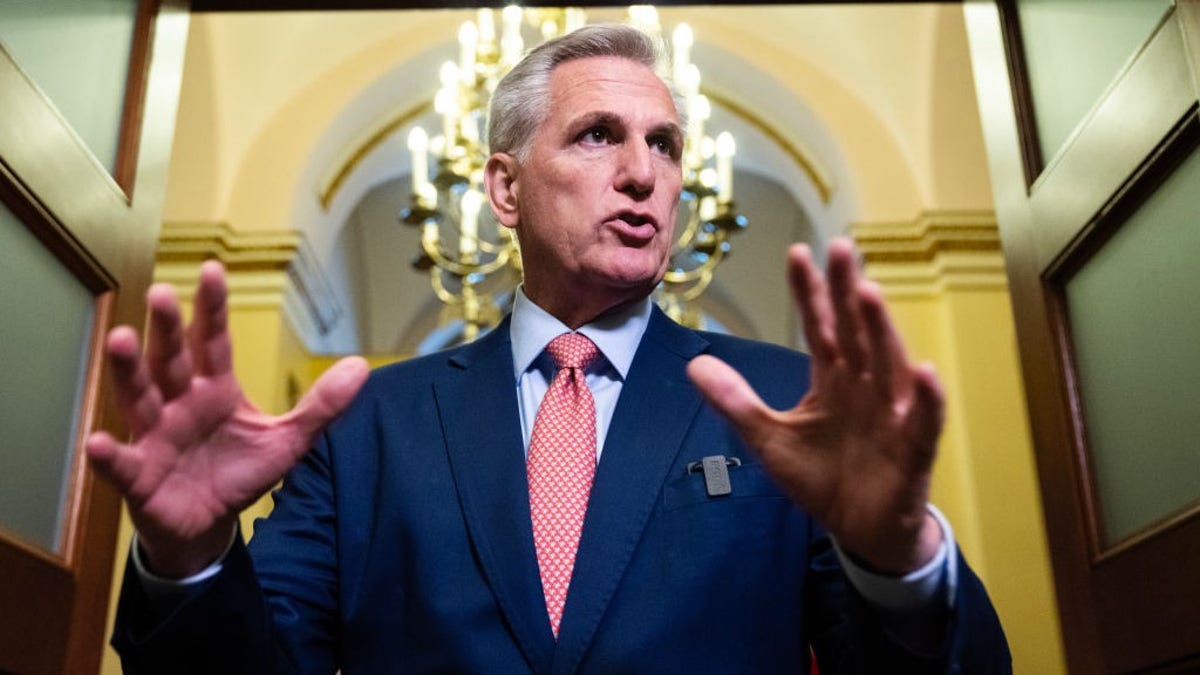West
Vince Fong advances in special election runoff to replace ousted House Speaker Kevin McCarthy

Californians voted to advance Republican State Assemblyman Vince Fong during Tuesday’s special election to replace former House Speaker Kevin McCarthy, who was ousted last year.
Fong, a former McCarthy aide endorsed by both McCarthy and former President Trump, faced off with Republican Tulare County Sheriff Mike Boudreaux at the polls on Tuesday.
Because both candidates are Republicans, the GOP will hold 218 seats, compared to the Democrats’ 213, factoring in four vacancies. In California’s jungle primary system, the top two vote-getters advance to the general election.
Fong, who also earned the most votes in March’s primary election, will serve out the rest of McCarthy’s term until he battles against Boudreaux again in November in the general election.
TRUMP ENDORSES EX-KEVIN MCCARTHY AIDE VINCE FONG TO FILL VACANT SEAT AS HIS FORMER AIDES BACK FONG’S OPPONENT
Assemblyman Vince Fong (right) advanced in California’s special runoff election on Tuesday, beating out Tulare County Sheriff Mike Boudreaux (left). (Carolyn Cole / ContributorMediaNews Group/Orange County Register via Getty Images / Contributor/ )
Fong and Boudreaux advanced to Tuesday’s runoff following a March special election where they emerged as the top two candidates, with neither getting more than 50% of the vote to trigger a victor. By November, voters in the district will have voted for either candidate a total of three times.
McCarthy resigned from the House in December, three months after he was voted out of the speakership.
The district, which cuts through the Central Valley farm belt, including parts of Bakersfield and Fresno, is the most strongly Republican House seat in heavily Democratic California. Trump largely carried CA-20 in 2020 and McCarthy represented the district from 2007 until his resignation in late 2023. In February, Trump called Fong “a true Republican.”
Among Boudreaux’s supporters are Ric Grenell, former acting director of national intelligence under Trump, and Republican state Sen. Shannon Grove, from Fong’s hometown of Bakersfield.
TULARE COUNTY SHERIFF MIKE BOUDREAUX ON THE CARTEL STYLE HIT THAT KILLED SIX PEOPLE

Despite winning the special election Tuesday, California Assemblyman Vince Fong will face Tulare County Sheriff Mike Boudreaux (above) again in November in the state’s general election. (Carolyn Cole / Los Angeles Times via Getty Images)
Trump’s involvement in the race casts it as a litmus test for the former president’s political relevance as he presumably gears up for a potential rematch against President Biden in November.
“I am proud to join California’s Republican Congressional Delegation, and give Vince Fong my Complete and Total Endorsement!” Trump wrote in a post on Truth Social. “Vince was one of only 6 Republicans in the State Assembly to stand with me, and reject the Second Impeachment Hoax. In Congress, Vince will work with me to Grow the Economy, Lower your Taxes, Cut Burdensome Regulations, Champion American Energy, and Protect and Defend the Second Amendment, which is under siege by the Radical Left.”
HOUSE VOTES TO REMOVE KEVIN MCCARTHY AS SPEAKER IN HISTORIC FIRST

Former House Speaker Kevin McCarthy was ousted in October and resigned from the House in December. (Getty Images)
In October, the House of Representatives voted to oust McCarthy, the first time in history the top leader of the lower chamber was booted from the job.
Fox News Digital’s Danielle Wallace contributed to this report.
Read the full article from Here

San Francisco, CA
San Francisco park renamed after grandmother who was fatally beaten: 'Hope and resilience'

SAN FRANCISCO (KGO) — There was a celebration of triumph over tragedy in San Francisco where a city park officially got a new name Saturday.
The Yik Oi Huang Peace and Friendship Park is named after the grandmother who was beaten there in 2019. She later died from her injuries. Relatives and community advocates want the new name to promote community healing.
It’s a new name and a new beginning for this city park in San Francisco’s Visitacion Valley.
Sasanna Yee talked about her grandmother, Yik Oi Huang, for whom this park is named. The official dedication taking place on Saturday.
“It’s been a very hard journey, very painful but also very beautiful,” Yee said.
88-year old woman brutally beaten in San Francisco park, granddaughters seek change
Yee said her 88-year-old grandmother came to this park, formally Visitacion Valley Playground, almost every day but in January of 2019, she was found badly beaten here and died months later from her injuries. The crime rocked the Asian Community. A 24-year-old suspect was arrested and is awaiting trial.
“She is survived by great-grandchildren and grandchildren, so having everyone come together as a family is really important,” Yee said.
Many hope the Yik Oi Huang Peace and Friendship Park will be a place of healing.
“I know it wasn’t easy. You turned a devastating loss into a win,” said Hermione Colthirst.
Relatives say renaming the park was originally the idea of community advocate Ronald Colthirst, who died last year.
89-year-old grandma, who was brutally attacked on San Francisco playground, dies 1 year later
“He would bring the African Americans and the Asians together as one. One of his legacies was to make sure we renamed this park,” said sister Brejea Colthirst.
“This is a true story of turning tragedy into triumph and making people understand we are better together,” said San Francisco Supervisor Shamann Walton.
San Francisco Mayor London Breed hopes generations to come will know Grandma Huang’s name.
“It’s symbol of hope, resilience for communities come together in times of challenge,” said Mayor London Breed.
Grandma Huang’s family hopes all will know peace and friendship when visiting here.
Copyright © 2024 KGO-TV. All Rights Reserved.
Denver, CO
One of Colorado’s least-visited canyonlands could become a national monument — but would that lead to overcrowding?

Those who love the Dolores River canyonlands agree — the swath of rugged land along Colorado’s western border is one of the state’s last, best wild places.
The tract encompasses staggering red rock cliffs, broad valleys and rolling hills that burst into green in the spring. Cutting through it all is the beloved river, which sometimes dwindles to a trickle.
Nobody wants to see it overrun with tourists and trash, like so many of the West’s wild places.
But disagreements about whether to designate some of the river and its canyonlands as a national monument have driven a caustic rift between the people who love the area. What those protections look like, and who gets to shape them, are at the center of a fiery debate that, in some instances, has sunk to name-calling and declarations of evil doing.
Recreation and conservation organizations want to designate nearly 400,000 acres, or 625 square miles, of the federal lands along the river as a national monument, allowing for more robust management and protection of the land. If approved, the monument would be the largest in the state and would nearly double the total acreage of monuments in Colorado.
The Dolores River canyonlands are one of the largest, most biodiverse swaths of lands without federal protections, advocates for the monument say. They worry that without further federal regulations, increased recreation, mining and development could threaten the integrity of the landscape.
“It’s a pretty incredible, intact landscape,” said Mike Fiebig with American Rivers, a nonprofit group that supports the monument designation. “We don’t have a lot of that anymore.”
Sean Pond, organizer of the Halt the Dolores Monument campaign, agrees. He can drive and hike for dozens of miles in the area outside of his home in Nucla without seeing anyone.
But Pond and thousands of other campaign opponents worry that a monument designation eventually would impact livestock grazing and limit a decades-dormant mining industry that could be revived with the recent rise in the price of uranium.
Or, worse, that creating a monument would draw the hordes of tourists that the landscape needs protection from.
“They come with a noble cause — they want to protect the Dolores River canyon,” Pond said of monument supporters. “So do we. We live here.”
Two efforts to protect river corridor
The monument proposal is one of two efforts to offer greater protection to the lands around the Dolores River.
The Dolores springs from headwaters in the San Juan Mountains near Telluride and flows southwest until it reaches the town of Dolores. From the small town, it turns north and meanders, eventually nearing Colorado’s western border, before crossing into Utah and joining the Colorado River northeast of Moab.
Colorado’s two U.S. senators last year introduced legislation nearly two decades in the making. It would designate a smaller swath of 68,000 acres along the southern Dolores River as a national conservation area and special management area. The area includes the river and its surrounding lands in Montezuma, San Miguel and Dolores counties.
The Senate Committee on Energy and Natural Resources in December approved the widely supported bill and recommended the full Senate pass it.
Two counties — Mesa and Montrose — dropped out of conversations about the national conservation area years before the bill was introduced, however.
In response, a coalition of recreation and conservation nonprofit organizations crafted the monument proposal for the lands around the northern sections of the river in those two counties. In 2022, the coalition began organizing support for the monument designation in Mesa and Montrose counties, home to about 202,000 people.
Unlike conservation areas, the designation of a new national monument on federal land doesn’t need congressional approval and can be created unilaterally by the president. Presidents have designated 163 monuments across the country, including nine in Colorado.
The Dolores River monument designation is necessary to protect wildlife, ecosystems and tribal connections and resources, monument supporters said.
“This landscape is one Instagram influencer away from being overrun, so let’s get the conservation right before it a problem,” said Scott Braden, director of Colorado Wildlands Project and one of the monument campaign’s organizers.

According to the proposal, the lands would be managed by the Bureau of Land Management and the U.S. Forest Service — as they are now — and subject to a management plan created by the entities with an opportunity for public comment. The monument would not charge entrance fees, according to the Protect the Dolores website. Livestock grazing would still be permitted, as would biking and use of motorized vehicle routes.
The government would honor existing and valid mining claims, though it would not allow new mining claims. The draft map of the proposed monument was crafted to exclude the majority of the existing mining claims, Braden said.
“We think there are places that shouldn’t be mined in this landscape … but we’re also leaving (out) a ton of areas that we think are most likely to see future mining,” he said.
So far, the coalition has collected more than 85,000 signatures and letters of support from 150 businesses, as well as some state and local politicians. Both of Colorado’s senators this year have traveled to the Western Slope to hear about the plan and talk with locals.
The Native American tribes with land in Colorado support the monument, too. Both the Ute Mountain Ute and the Southern Ute lived in the area of the proposed monument, said Regina Whiteskunk, a member of the Ute Mountain Ute and a former tribal councilmember.
The land needs to be kept as close to its natural state as possible, she said.
“This landscape provided everything for us and we survived that way for hundreds of years,” she said. “And now we’re trying to do right by the land.”
Advocates are hoping President Joe Biden will turn his attention to the idea before the November election. While Biden has designated five new national monuments — including the Camp Hale-Continental Divide National Monument north of Leadville — former President Donald Trump, who’s the likely Republican nominee again this year, created a single monument and reduced the size of another while in office.
The coalition believes the monument would help local communities by boosting outdoor recreation economies, while continuing the mining and ranching industries.

Distrust and name calling
But some in the small towns along the proposed monument’s boundary don’t buy those claims.
Pond is not sure the land needs more protections. The area’s minimal tourists need little management now, he said, but he fears that designating a monument would act as a siren call to the hundreds of thousands of RVers, bikers, motocrossers and hikers that descend on nearby Moab every year.
Visitation to the area increased in 2020 when the COVID-19 pandemic prompted many people to seek wilderness solitude, Pond said. People were camped “every-freakin’-where” that year, Pond said, but the fervor has since calmed. There is no true tourism industry in the area, he said.
Pond and others with Halt the Dolores fear that despite promises from the monument advocates, access and use regulations will change in the future. Nearly 8,000 people have signed Pond’s petition to halt the designation. County commissioners from Mesa County and Montrose County passed resolutions opposing the monument, though the mayor of Grand Junction — the largest population center in the area — supports the monument and traveled to Washington, D.C., in April to lobby for its creation.
Even if grazing is still allowed on the land, changes to motorized access could affect the feasibility of reaching cattle or maintaining ranching equipment, Pond said. Or, if the monument designation grandfathers a mining claim, blocked access could make it useless.
“They’ve said we’re spreading misinformation,” Pond said. “But I’m just spreading the other side of the truth.”
Pond also opposes a ban on new mining activity. With the price of uranium rising, the towns along the uranium belt could see a mining boom. Minimum-wage tourism jobs are not the same as the potential six-figure mining jobs such a boom could bring.
In a post on social media, Pond alleged that a monument designation would lead to entrance fees and closed-off lands, roads and trails.
Colorado’s nine national monuments cover a combined 490,000 acres and vary widely in size and management. The five created before the turn of the century are managed by the National Parks Service and the four created since are managed by the BLM and the U.S. Forest Service. Five of the nine charge an entrance fee.

Braden, from the Colorado Wildlands Project, said the monument, as proposed, would not be operated similarly to the Colorado National Monument, which is heavily developed and sits just outside Grand Junction. A better comparison would be to the Camp Hale or Canyons of the Ancients national monuments.
The debate over the monument has resulted in name calling and harassment, both sides said.
On Facebook, Pond has called supporters of the monument “eco-terrorists” and called Braden a “parasite” and “the embodiment of evil.” Others opposing the monument have called local businesses that support the monument a “cancer on the community.”
When asked about the posts, Pond said his emotions have sometimes gotten away from him and that he’s trying to be more politically correct.
He did not apologize and said that if his language brings attention to his cause, “then so be it.”
Pond said he also has faced harassment, including a death threat he said he reported to law enforcement. He also cited a woman who screamed at him from across the room at a community meeting last Sunday in Nucla.
The inaccurate talking points and name-calling from those who oppose the monument have been disheartening, Braden said. But he believes compromise is possible.
“We’re ready to come to the table and meet people where their concerns lie and try to figure something out that’s workable for everybody,” said Braden, who lives in Grand Junction. “But at the end of the day, we’re committed to permanent protection of this landscape.”
Get more Colorado news by signing up for our Mile High Roundup email newsletter.
Seattle, WA
New York Mets Trade Pitch Lands Seattle Mariners Top 10 Prospect for Pete Alonso

The New York Mets are scorching hot, winning eight of their last 10 games. Still 14.5 back in the National League East, the chances of winning the division are slim to none.
Despite the frustration and poor play for much of the season, they only sit two games back from a Wild Card spot.
If the Mets had continued to lose games like they were just a few weeks ago, selling seemed like the ideal situation. With about a month left before the MLB trade deadline, this could change things.
While they certainly aren’t World Series contenders as currently constructed, crazier things have happened. Baseball is tougher than any sport when it comes to winning in the postseason, and previous playoffs indicate that anything can happen.
However, the elephant in the room is still on what they plan to do with slugger Pete Alonso. The right-handed hitter hits free agency at the end of the year and is expected to sign a contract that could exceed $200 million.
If Steve Cohen and the front office don’t have any plans on paying him, keeping him for the remainder of the season doesn’t make much sense. If they’re willing to give him what he’s looking for, trading him doesn’t make much sense.
No matter what situation they’re in as a team, their plan shouldn’t change.
In the scenario where they do move him, many teams around the league will be interested.
A proposed trade from Matt Johnson of Sportsnaut has Alonso getting dealt to the Seattle Mariners for Jonatan Clase.
“The New York Mets are fully committed to selling at the MLB trade deadline and the reported Pete Alonso contract demands mean an extension likely won’t even be pursued. Alonso’s status as a half-season rental will likely drive down his trade value considerably, putting him in a more affordable range for the Seattle Mariners.”
The 22-year-old Clase is viewed as a top-10 prospect in the Mariners organization. He made his MLB debut in 2024, appearing in 15 games. The switch-hitting outfielder has struggled, slashing .176/.200/.206 with 13 strikeouts in 34 at-bats.
Only 34 at-bats into his big league career, it’s impossible to make a judgment on him as a player at this level.
If New York had moved him a year ago, the return would’ve been much better than it’ll likely be, another factor they have to think about. Instead, they find themselves in one of the toughest positions in the league.
-

 News1 week ago
News1 week agoIsrael used a U.S.-made bomb in a deadly U.N. school strike in Gaza
-

 World1 week ago
World1 week agoFrance to provide Ukraine with its Mirage combat aircraft
-

 World1 week ago
World1 week agoRussia-Ukraine war: List of key events, day 833
-

 Movie Reviews1 week ago
Movie Reviews1 week agoInsane Like Me? – Review | Vampire Horror Movie | Heaven of Horror
-

 News1 week ago
News1 week agoNonprofit CFO Accused of 'Simply Astonishing' Fraud
-

 Politics1 week ago
Politics1 week agoGeorge Clooney called White House to complain about Biden’s criticism of ICC and defend wife’s work: report
-

 Politics1 week ago
Politics1 week agoNewson, Dem leaders try to negotiate Prop 47 reform off California ballots, as GOP wants to let voters decide
-

 World1 week ago
World1 week ago‘Bloody policies’: Bodies of 11 refugees and migrants recovered off Libya













